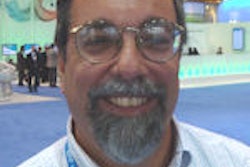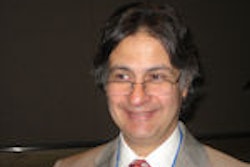Giving radiologists access to computer-aided detection (CAD) technology directly on their PACS workstation software can boost the number of lung nodules detected on low-dose CT screening exams, according to research presented at the 2009 RSNA meeting in Chicago.
A research team from New York University Langone Medical Center in New York City found that the marriage of CAD with PACS significantly increased the number of true-positive nodules identified for all readers in the prospective study. These gains were also judged to come with an acceptable number of false-positives per case.
"The use of CAD when it's truly seamlessly integrated into a PACS system was assessed as a valuable addition in the setting of low-dose CT screening studies," said presenter Dr. David Naidich.
Although CAD has been shown repeatedly to improve the detection of solid lung nodules, the researchers wanted to investigate if CAD could add particular value if seamlessly integrated within a PACS environment. This would allow radiologists to have simultaneous access to CAD information as they read studies, as opposed to having to use an independent CAD workstation.
The researchers focused on the potential role of CAD integrated into a PACS on reading workflow for detecting lung nodules in a high-risk population receiving low-dose screening CT exams. They selected 45 consecutive exams from January 2007 to April 2007 as part of an ongoing Early Detection Research Network (EDRN) program funded by the U.S. National Institutes of Health (NIH). Three cases were eliminated for technical factors.
The studies were performed on 64-detector-row CT scanners from Siemens Healthcare (Malvern, PA) and were obtained using a low-dose screening protocol with 1-mm collimation; reconstructions were sent to both the PACS and a CAD server. The CAD server then developed axial CAD screenshots containing potential nodules, which are viewable by radiologists on the PACS workstation.
The images were processed with Siemens' syngo lung CAD (VC10A) application, and the cases were interpreted in randomized order by five dedicated thoracic radiologists. All of the radiologists had experience using CAD on a PACS, Naidich said.
The cases were initially read without CAD, interpreted using continuous 5-mm images. All noncalcified lung modules ≥ 3 mm were measured with calipers, marked, and assigned a confidence level using a five-point scale (1 = least, 5 = most).
Immediately afterward, the CAD findings were available to the readers and were subsequently interpreted as either true-positive or false-positive findings. Each true-positive finding was characterized as previously initially identified by the reader, or as a new finding that was then further defined as a significant or insignificant cancer, he said. Size, location, and confidence were also noted.
All five reader findings were then consolidated with an automated algorithm, using a minimum distance between nodules to identify overlap. A true-positive gold standard was established based on agreement between three, four, or five readers. Nodules identified by fewer than three readers were adjudicated by two independent interpreters by consensus.
Interpretation times were automatically measured first for readers alone, then separately for the time taken for additional CAD interpretation. Also, study readers were asked to complete a brief questionnaire to assess their perceived value of CAD in a PACS environment.
Overall reader sensitivity
|
CAD added an average of 4.85 additional findings per case, including 0.43 new true-positive and 1.85 false-positive results. The use of CAD added an average of two minutes, 12 seconds, per case to reading times.
In other findings, readers both with and without CAD had an average of less than one false-positive finding per case.
Readers also found CAD to be valuable. Four of five radiologists said the extra time needed for CAD was acceptable, while all five believed the system yielded acceptable sensitivity.
To address the trade-off between sensitivity and false-positive rates, the researchers asked the readers to identify the number of false positives acceptable for a given potential system. There was a wide diversity of opinion on this matter, he said.
The team acknowledged several limitations of the study, including the exclusion of subsolid nodules and reliance on a select population of low-dose screening studies. In addition, interpretations were only performed by dedicated thoracic imagers, and the study lacked histologic correlation. Interpretation reporting times also included the scoring and annotations of individual nodules, Naidich said.
In other study implications, CAD systems in the future should be able to be tailored to the varying needs of different readers, he said.
"Ideally, a CAD system would enable readers to say how many nodules they want to see, and what size of the lesions they want to see," he said.
By Erik L. Ridley
AuntMinnie.com staff writer
December 18, 2009
Related Reading
CT lung CAD helps readers differently, November 4, 2009
Brazilian team marries lung CAD with PACS, August 20, 2009
CARS report: New CAD tool follows lung nodules over time, June 30, 2009
CAD performs well in subsolid pulmonary nodules found with CT, May 15, 2009
Integrating lung CAD with PACS boosts utilization, March 6, 2009
Copyright © 2009 AuntMinnie.com




















